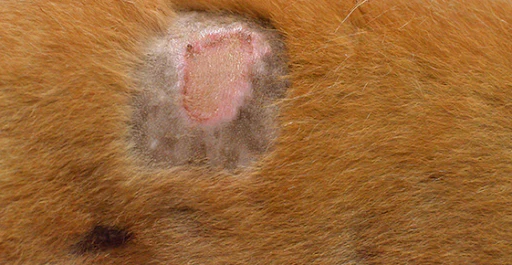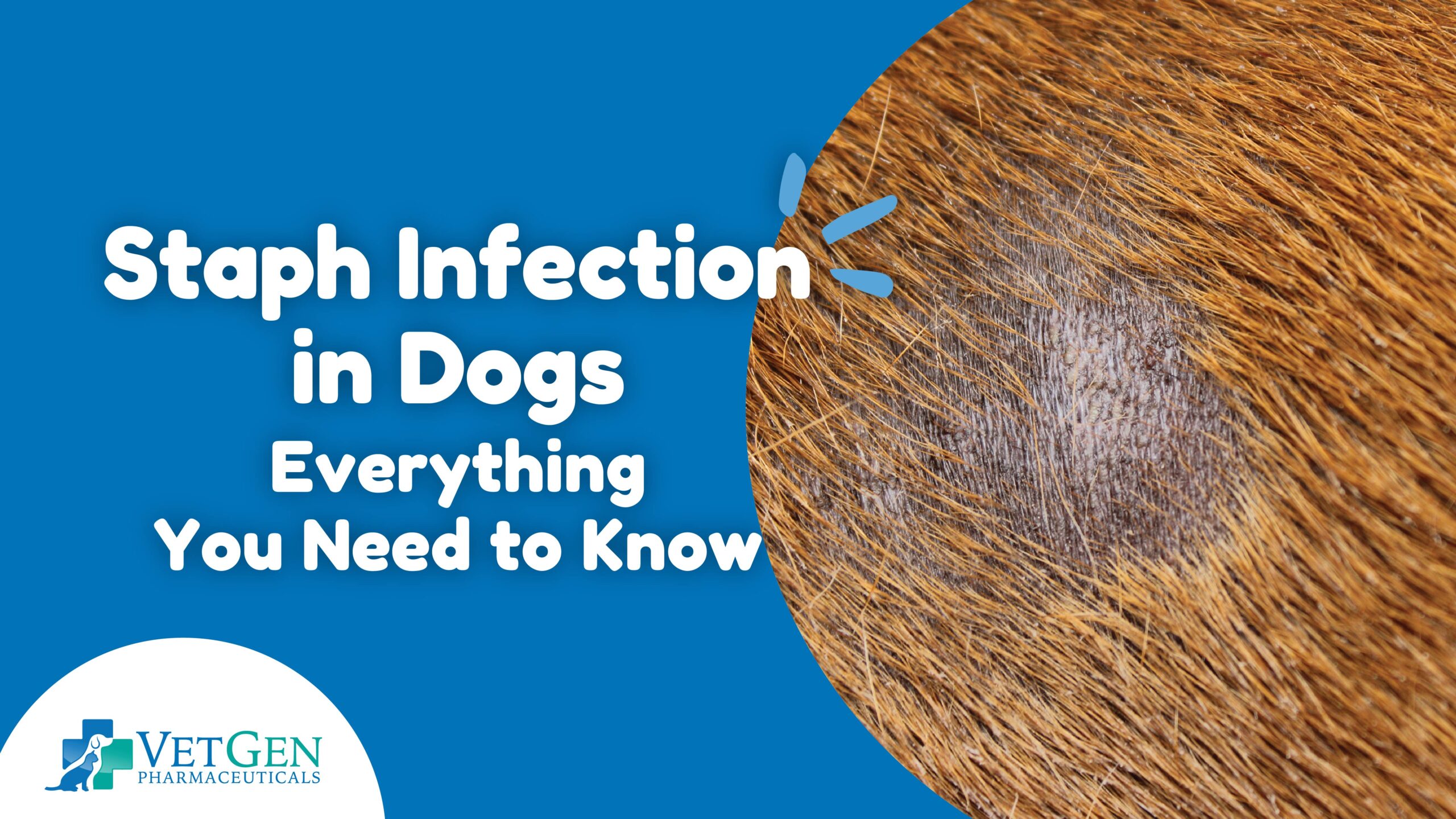Ever found your dog bent over, itching, biting, and licking a red area with crust on their skin? That is likely an indication that your dog is suffering from a staph infection.
What is Staph Infection in Dogs?
Staphylococcus is a type of bacteria naturally found on the skin of mammals, humans and dogs alike. These bacteria are opportunistic in nature, meaning they’re always waiting for the skin to sustain an injury or irritation to attack.
When the skin is healthy, staph will remain harmless. However, once your dog’s immune system is weak and the skin isn’t at its optimum health, it can invade and grow rapidly, finding its way further down into the body to cause harm.

Can Staph Infection Lead to Death for Dogs?
While most staph infections are curable with antibiotics, in rare cases, treatments might prove abortive. This happens when the staph strains behind the disease are antibiotic-resistant, also known as MRSA (Methicillin-resistant staphylococcus aureus). It’s good to note that this condition can lead to severe pyoderma, septicemia, and death if not attended to quickly by a vet.
Other rare strains exist that produce toxins that lead to canine toxic shock syndrome (CTSS) and organ failure. These are severe complications that can lead to death if not attended to urgently. CTSS leaves a once healthy dog rigid with severe spasms.
Canines experiencing CTSS will naturally be weak and immobile. They will likely run very high temperatures, followed by bleeding, deep cough, the appearance of bruises, bloody cough, bloody diarrhea, and death. This is why you need to contact your vet the moment you suspect a staph infection.
Causes of Staph Infection in Dogs
Staphylococcus can’t break into the skin and cause harm on its own. Wounds, allergies, and a weak immune system are all primary causes of the infection.
When your dog sustains an injury or scratches, chews, or licks the areas on their skin due to irritation, parasites, or allergies, they give room for the staph present in that area to act. The immune system also contributes to this condition, which is why adult canines are more susceptible to staph infection than younglings.
Other possible causes of a staph infection include:
- Mouth, eye, and nose contact with contaminated materials
- Infected medical equipment
- Consumption of contaminated materials
Symptoms of Staph Infection in Dogs
Staph infection symptoms vary depending on what part of the body the infection is occurring. If the bacteria is still on the surface, the signs should be tied to the surface and surrounding of the affected area, which includes:
- Skin inflammation
- Crusting
- Abnormal wound scaling
- Abscess
- Hair loss
- Itching
- Sensitivity around affected areas
- Rash
- Itchy ears and increased wax
Secondary symptoms based on location and the staph strain causing the infection includes:
- Secondary ear, eye, and nose infection
- Loss of appetite
- Extreme temperature
- Coughing blood
- Bloody diarrhea
- Deep dry cough
- Rigidity
- Muscle spasms
- Bleeding from the nose
- Bruises on the skin
- Blood poisoning
- Shock
On the off chance your canine experiences one or more of these symptoms, visiting your vet doctor is a matter of emergency as your canine could die in a matter of hours.
Where can Staph Infection Appear in the Body?
Though staphylococcus infections usually appear on any part of the skin around irritated areas and injuries, they can also surface in organs within the body, causing fever and weakness as symptoms.
In addition to these symptoms, your dog could experience other symptoms depending on which organ is affected. These symptoms include:
- Severe pain
- Weight loss
- Swelling
- Tremors
- Lack of coordination
- Fever
- Shock
- Extreme temperature
Dogs with chronic ailments, burns, and wounds are more prone to experience other health complications from internal staph infections. It is vital to act quickly by visiting your veterinarian.
Treatment of Staph Infection in Dogs
Primary Care
In most cases, antibiotics administration is all the treatment that is needed. Your vet doctor will prescribe the correct topical antibiotics cream for your dog as well as the duration in a case of skin infection.
The veterinarian might also recommend an oral antibiotic to administer to your dog in conjunction with the cream. This is to prevent the bacteria from spreading into the body. Your vet will explain the application process to you to ensure you administer the treatment correctly.
In the case of an MRSA infection, regular antibiotics administration will likely not work. Your vet doctor will take culture to determine the appropriate oral antibiotics to treat the infection. Treatment can last for four to eight weeks or more.
Internal staph infection often requires more than antibiotics. Depending on the situation, your veterinarian will administer a series of treatments required in addition to antibiotics to get your pet back to total health. These treatments might include:
- Excess fluid drain
- Surgery
- Necrotic tissue removal
Secondary Care
While you follow the vet’s instructions to administer treatments to your canine, you should ensure that their living environment is warm and clean. Alongside this, preparing a medicated bath and shampoo treatment for them during this phase is crucial for a speedy recovery.
Discuss with your veterinarian what shampoo and medical bath are best for your dog’s condition. In the case of hair losses and skin dryness, consider the best dog supplement for dry skin to alleviate your canine’s sensations while recovering their full hair.
How to Prevent Staph Infection Recurring in Dogs?
Most mammals have staphylococcus naturally on their skin. The key to keeping them out of our bodies is to ensure general optimum health.
In your efforts to do so, identify the root problem behind the development. If the infection appeared after your dog continued to bite, lick, and scratch a particular spot, the culprit could be a parasite, allergy, or other irritants.
Have that checked and addressed. As a routine, ensure your dog’s wellness is examined periodically. Take them to the vet to ensure they’re on par with the required vaccination and pest control treatments. In addition, provide them with healthy meals and a healthy environment.
Here at VetGen Pharamaceuticals, we strive to provide optimal care to raising a healthy, active, and happy dog. That is why we go the extra mile to create the best dog supplements for dry skin as well as other supplements, to prevent and treat various conditions. All of our products adhere to the highest industry standards and practices. Do not hesitate to contact us for all your queries.
References:
- Wag Walking https://wagwalking.com/condition/staph-infections
- Vet. World (2012) Canine Streptococcal Toxic Shock Syndrome associated with Necrotizing Fasciitis: An Overview
- Kansas State University K-State Veterinarian Issues Canine “Toxic Shock” Advisory
- Pet & Claws https://pawsandclawsvet.com/staph-infections-your-pet/






